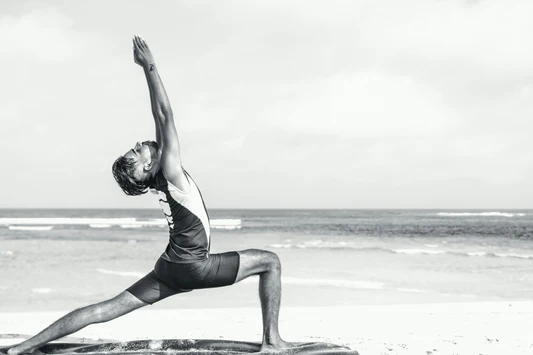Starting when were young we are told to watch our posture, mainly because expressing poor posture tends to transmit a less desirable image than good posture does.
What defines “good posture” though?
If you think about it, a slouched individual sends a different message than someone with an upright posture. The posture we display can be a direct result of emotional factors, biomechanical issues and habits.
The human body is designed to operate in synergy and disruptions in proper posture for too long of a time can have negative consequences.
Postural defaults alter the normal anatomical relationships throughout the body and can contribute towards biomechanical neck pain, shoulder pain and back pain resulting in issues further along the upper and lower extremity kinetic chain.

In this article we will discuss what proper posture looks like along with some simple techniques used to correct faulty posture. These techniques will be useful for the ability to maintain it throughout daily activities, working and training.
But first, have these items on hand to be able to perform the corrective exercises:
- Foam Roller
- Resistance Bands
- Towel
What Problems Does Bad Posture Cause?

Normal spinal alignment consists of maintaining the natural curvatures of the spine, which are cervical extension, thoracic flexion and lumbar extension.
The spine’s natural curvatures allow for load acceptance throughout the body while providing mobility.
Problems arise when these are excessive deviations in these curvatures in such forms as kyphosis; excessive thoracic flexion or hyperlordosis; excessive lumbar/cervical extension.
These deviations can occur from muscle imbalances, environmental factors such as occupation or sport, habitual behaviors and in some cases, congenital or hereditary factors.

What Is Normal Posture?
Normal posture constitutes a balance of upper cervical flexion, lower cervical extension, thoracic extension and rotation, lumbar extension, flexion and rotation.
The most common postural default is a “forward head” and thoracic kyphosis which results in a head protracted forward so the skull is anterior to the rest of the spine and the thoracic spine is excessively flexed.
This results in excessive extension of the upper cervical segments, limited rotation, limited thoracic extension and rotation and limited shoulder motion.

Normal Posture

Illustration of normal cervical position vs. a protracted head posture
To appreciate the difference:
- Try slouching with your head pushed forward.
- Try rotating your head side to side and then also try elevating your shoulders while staying in a slouched position.
- Then try sitting upright with your shoulders back and head drawn inwards.
- Rotate your head side to side and then elevate your shoulders.
In which position way do you achieve greater cervical rotation and shoulder elevation?
The use of technology has certainly contributed to a higher prevalence of poor posture. Increased use of computers, lap tops, tablets, smart phones and portable video game devices all promote a forward dominance of posture.
Currently, with the recent pandemic and people working from home or remotely, there is more engagement on portable devices in suboptimal positions such as the couch, bed, Kitchen Island or poor supportive chairs.
Many people did not have a proper work from home set up when the pandemic hit but despite the home environment, many workplace settings have less then ideal set-ups for their employees as well.

Example of proper ergonomics and work desk set up metrics
Increasing awareness of posture and practicing simple techniques such as the basic exercises described next, can help prevent postural defaults and the negative results that come with them.

Illustration demonstrating kyphosis posture in the thoracic spine
Exercises To Correct Bad Posture
Cervical Retraction

Start position and end position of the supine chine retraction exercise
This exercise helps to correct the protraction or forward head position.
- Commonly referred to as the “double chin” or “ chin tucks”, it is executed by drawing the head straight back.
- Some tension may be felt on the base of the skull and the front of the throat since these are the muscles being exercised.
- Using two fingers overpressure can help guide the head in the proper direction.
- Starting supine is a good way to learn the movement where the spine is unloaded before progressing to sitting and standing.
If your head is in an extended position when lying on your back, which can occur due the loss of upper cervical flexion, use a towel roll under the base of the skull to help keep your head neutral.

Then practice the chin retractions from this position. Eventually you should be able to lie on your back with head naturally in neutral.
Once the movement is mastered in the supine position, progress to sitting and then to standing.
When sitting and standing, make sure your scapula are squeezed back and down to avoid slouching.
Slouching during the seated or standing cervical retraction exercise nullifies the efficiency of the movement as it can tend to block the proper motion of the cervical segments.

Cervical retraction in seated with finger overpressure
The starting goal is to hold for 2 seconds and repeat 10 times. The ultimate goal is to practice this throughout the day when sitting and standing.
Cervical Flexion

This exercise helps to target the muscles on the front of the throat that flex the neck. These muscles tend to get stretched out and weakened with a forward head posture.
It is best to complete this one when lying supine.

Anatomy of some of the anterior cervical muscles
First execute a chin retraction and while holding the position, elevate your head off the floor while still maintaining the chin retraction.

- Touch your chin to your chest and then continue to maintain the chin retraction on the way down.
- If this is too aggressive for you at the time, place a small towel rolled up on your throat and practice pressing into the towel. This will shorten the range the neck has to go through until the muscles get stronger.
- Repeat for 2-second holds and 10 times.
Thoracic Foam Roller Extensions

Use a foam roller to help promote thoracic extension.
- Lying on your back with your hips on the floor and the foam roller at your mid to upper back level, cross your arms across your chest and gently lean back over the foam roller.
- Only go as far as you can until you feel a stretch. Avoid any intense pain.
- Progress to hands behind the head position for a more aggressive stretch once the arms across the chest becomes more comfortable.
- Work the range slightly more over a course of 15 repetitions.
Prone Scapula Retraction

Prone scapula retraction start and end positions
This exercise helps to train the proper movement of the scapula to correct a slouched and rounded shoulder posture.
- Lying on your stomach with your forehead resting on a small towel, squeeze your shoulder blades back and down in a “V” direction towards your mid back.
- The front of your shoulders should come off the floor and move backwards.
- Hold for 2 seconds and slowly lower down. Repeat 15 times.
- Once this movement is mastered, progress to adding a shoulder extension movement with the scapula squeeze.
Seated Over Slouch Correct

This exercise helps for practicing awareness of poor posture.
- While sitting, purposefully slouch with your back rounded, shoulders forward and head forward.
- Then correct it by implementing the chin and shoulder retraction movements.
- Sit upwards by squeezing your shoulder blades back and down, drawing the chin in and looking straight ahead.
Quadruped Chin Retraction

This exercise helps to train the sub occipital musculature in a more challenging position, quadruped, which forces the neck to work against gravity.
This is beneficial for practicing good control of the neck when leaning forward doing tasks such as lifting or pulling.
- Looking straight ahead with your head neutral, draw the head straight back in the same manner practiced when lying supine and also sitting.
- Hold for 2 seconds and repeat 15 times.

Anatomy of sub occipital musculature. These muscles help to coordinate the movements and maintain the angles required to hold the head at various positions.
Rows

Close grip row start and finish position
Any type of rowing movement will help promote scapula retraction and to reduce a slouched posture. There are many variances of rowing movements, especially for training purposes but a simple close grip row is a good place to start.
Once the concept is mastered with light resistance and proper form, progression to other types of rows can be beneficial to train the muscles under different demands.
The main focus of the basic close grip row is to ensure the scapula are pulling down and back to correct the slouched shoulder position. Focus on the scapula finishing the movement as opposed to pulling the elbows back past the torso.

Anatomy of back and scapula musculature
Posture correction may seem awkward at first and can sometimes be a challenge to stay compliant with but the benefits of practicing proper technique will outweigh the results of neck, back and shoulder pain.
About The Author:
Michael St. George PT, DPT has been practicing for 10 years primarily in the outpatient and orthopedic setting. He works for a physical therapist owned private practice based in the greater Philadelphia area and surrounding suburbs. Mike is certified through Functional Movement Systems for FMS, SFMA and FCS which consist of screens and testing used to measure movement quality and performance. Mike also has experience with working with numerous surgeons and physicians from the Rothman institute. Currently he works primarily with ACL, meniscus and post surgical recovery and sports injuries, return to sport testing and performance, running evaluation and re training and hand and upper extremity conditions.


